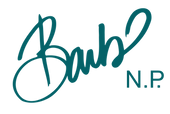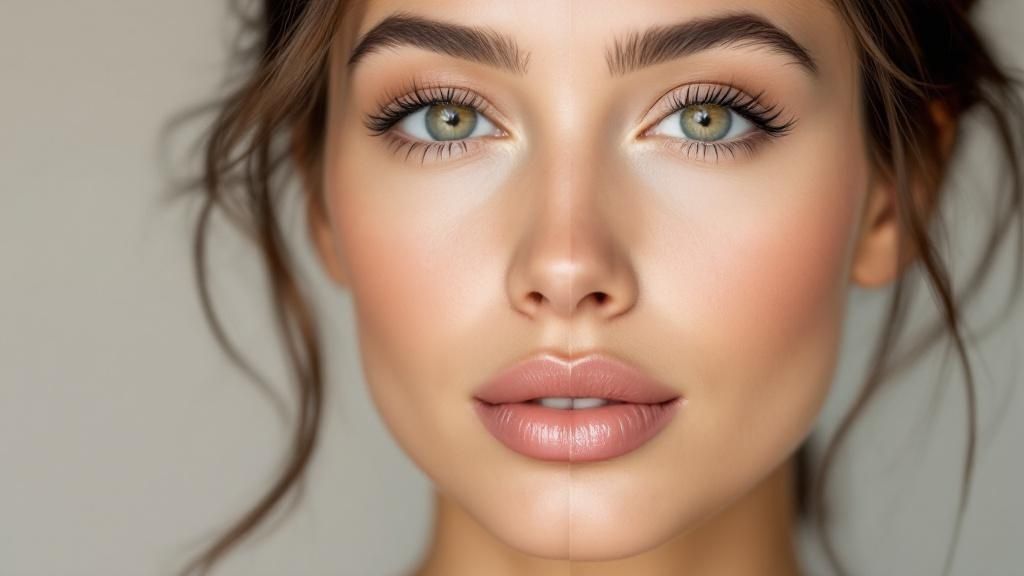
When it comes to injectables, the first question I always hear is, “What’s the difference between Botox and fillers?” It’s a great question, and the answer is simpler than you might think.
The core difference comes down to this: Botox stops muscles from moving, while fillers add volume.
Think of Botox as the solution for smoothing away wrinkles caused by your expressions—like crow’s feet from smiling or forehead lines from raising your eyebrows. Fillers, on the other hand, are designed to quite literally fill in the lines and hollows that are there even when your face is perfectly still.
Botox vs. Fillers: A Direct Comparison
To really understand which treatment is right for you, it helps to see them side-by-side. While both are injectables administered by a professional, they work in completely different ways to achieve distinct aesthetic goals. One is a relaxer, and the other is a volumizer.
Botox, which is a brand name for a specific type of botulinum toxin, works by temporarily blocking the nerve signals that tell your facial muscles to contract. This softens the dynamic wrinkles created by movement. In contrast, dermal fillers like Restylane are typically made from hyaluronic acid, a substance that naturally occurs in the body. They work by physically adding back lost volume, plumping up static wrinkles and restoring youthful contours to the face.
At a Glance: Botox vs. Dermal Fillers
This quick table breaks down the fundamental differences between the two, giving you a snapshot of what to expect from each treatment.
| Attribute | Botox | Dermal Filler (e.g., Restylane) |
|---|---|---|
| Primary Use | Relaxes muscles to treat dynamic wrinkles (e.g., crow's feet, forehead lines) | Adds volume to fill static wrinkles and restore contours (e.g., nasolabial folds, lips) |
| How It Works | Blocks nerve signals to muscles | Physically fills space with a gel-like substance (hyaluronic acid) |
| Onset of Results | Gradual, over 3-7 days | Immediate |
| Duration | 3-4 months on average | 6-18 months, depending on the specific product and area treated |
| Best For | Expression lines | Volume loss, deep folds, enhancement |
As you can see, the right choice really depends on the specific concern you want to address.
Key Differences At a Glance
This simple visual helps illustrate how each injectable tackles different signs of aging.
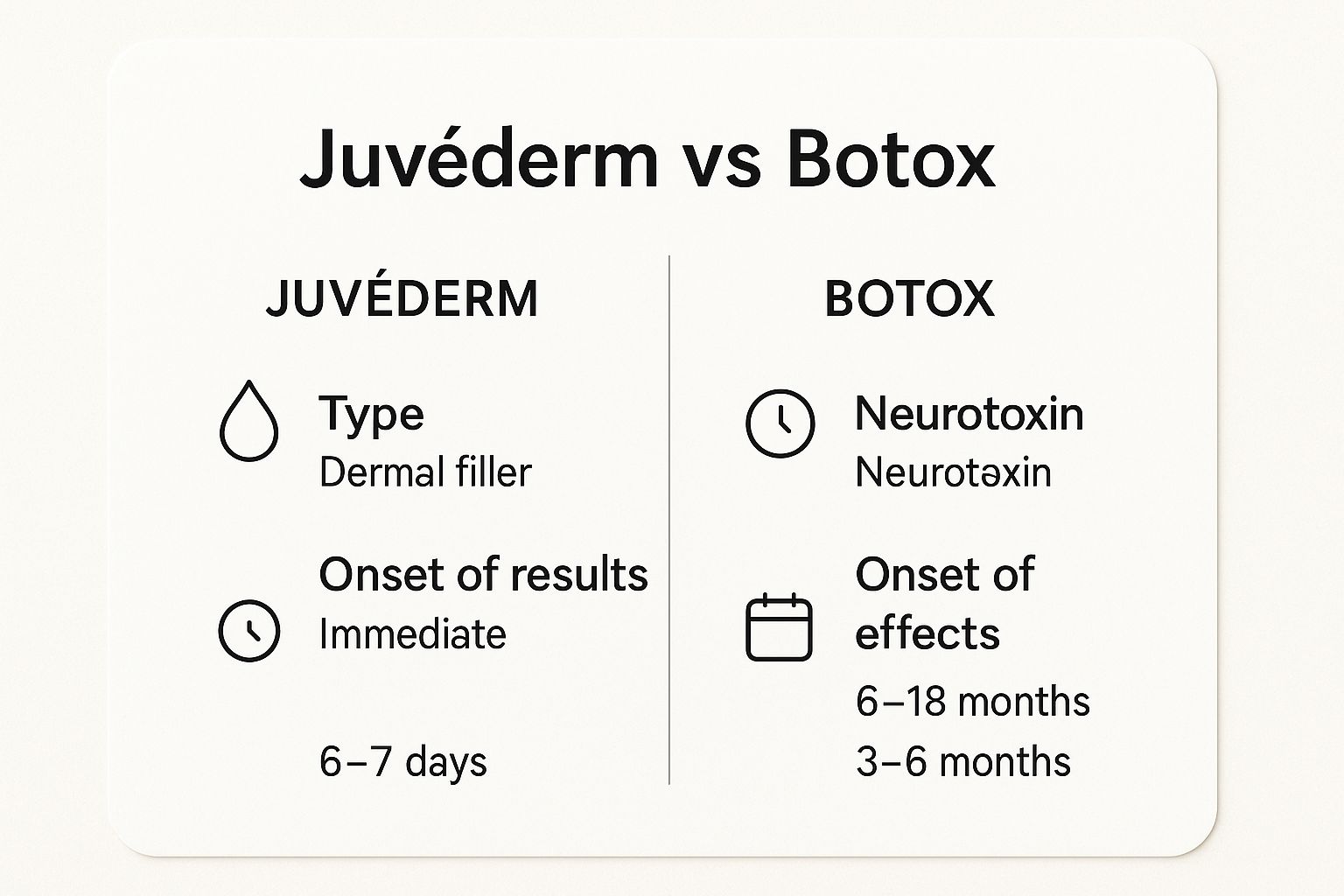
It’s a great reminder that fillers provide that instant plumping effect, while Botox needs a few days to work its magic and relax the muscles.
Key Takeaway: The choice isn't about which is "better," but which is correct for your specific type of wrinkle. Dynamic lines from movement require Botox, while static lines from volume loss require fillers.
For a more in-depth look at how neuromodulators like Botox can transform your look, you can check out our guide on the benefits and procedures for Botox. This will help you understand its role in achieving beautifully natural-looking results.
Ultimately, the best approach is a personalized one. Consulting with an expert here at BARB N.P. is the surest way to create a treatment plan that addresses your unique goals—which, for many of my clients, often includes a combination of both for a total facial rejuvenation.
How Botox Works to Relax Expression Lines
To really grasp the difference between Botox and fillers, you have to look at what’s happening beneath the skin. Botox isn’t a filler at all; it’s a neuromodulator. Its entire job is to get to the source of the problem by targeting the facial muscles that cause expression lines in the first place.
Think about it: your nerves are constantly firing off signals, telling your muscles to contract every time you smile, frown, or look surprised. Over the years, these repetitive movements make the skin on top crease, and eventually, those creases stick around as permanent lines.
Botox works by gently interrupting that conversation. When an expert injector like BARB N.P. places it into specific muscles, it temporarily blocks those nerve signals. The muscle simply can’t contract with the same intensity, which gives it a chance to relax.
The Science of Smoothing
That muscle relaxation has a beautiful effect on the skin's surface. As the muscle underneath softens, the skin lays flat and smooths out, dramatically reducing the appearance of those dynamic wrinkles. This is exactly why Botox is the gold standard for treating:
- Crow’s feet that fan out from the eyes
- Forehead lines that pop up when you raise your brows
- Glabellar lines, often called the “11s,” between your eyebrows
Essentially, Botox quiets down the muscle activity that creates the wrinkle. It’s a targeted solution for lines caused by movement, which is a completely different approach from fillers that add volume to lines that are there even when your face is at rest.
By preventing the skin from constantly folding in the same places, consistent Botox treatments can also be a powerful preventative tool. It helps stop expression lines from getting deeply etched into your skin, offering a proactive way to maintain a smoother, fresher look.
This preventative angle is a huge reason why so many people start Botox treatments before their lines become too deep-set. It’s not just about erasing wrinkles that are already there, but about stopping new ones from forming. The goal is always a refreshed, natural appearance—not a "frozen" one. An experienced injector knows the precise dosage and placement needed to soften lines while still preserving your natural, beautiful expressions.
How Fillers Like Restylane Restore Facial Volume
While Botox works on the muscles creating expression lines, dermal fillers like Restylane tackle the problem from a completely different angle. Their job is to address static wrinkles—the lines and folds you see even when your face is perfectly still. The core difference is simple: fillers physically add back lost volume.
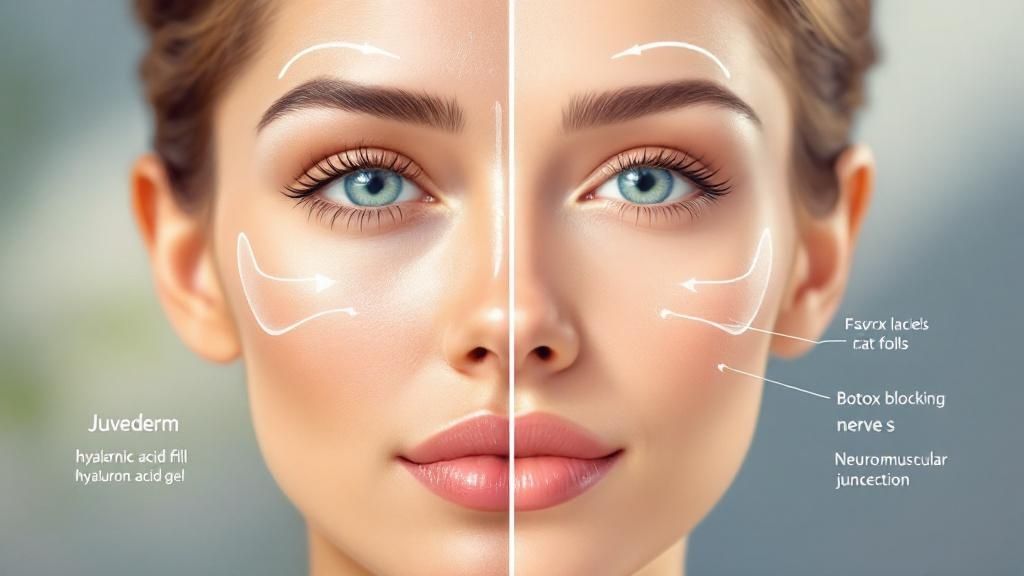
Most fillers are made from a smooth, gel-like substance called hyaluronic acid (HA), which your skin produces naturally. Think of HA as your body’s own internal moisturizer and scaffolding. But as we age, our natural HA supply dwindles, leading to sunken areas, sagging skin, and deeper lines.
When an expert provider like BARB N.P. injects a filler, she is quite literally rebuilding that lost support system from underneath the skin. The HA gel integrates with your tissue, providing immediate lift and plumpness. It also draws in water, which enhances hydration and fullness for a soft, beautiful result.
The Art of Volumizing
This ability to restore volume is what makes fillers so incredibly versatile. They are the perfect tool for concerns that Botox simply can't fix. A skilled injector can use different fillers to achieve very specific goals, tailoring the treatment to your unique facial structure.
Common uses include:
- Softening nasolabial folds (the "smile lines" running from your nose to your mouth).
- Augmenting lips to add fullness, sharpen the border, or correct asymmetry.
- Lifting and contouring cheeks to bring back a youthful, elevated shape.
- Filling in under-eye hollows (tear troughs) to erase a tired appearance.
Unlike Botox, which takes several days to relax muscles, the results from dermal fillers are visible right away. You walk out of the appointment with an immediate improvement, seeing the plumping and lifting effects on the spot.
Different formulas within a filler family, like the Restylane line, are designed for specific jobs. For instance, a thicker, more structural filler is used for cheek lifting, while a softer, more flexible one is ideal for subtle lip enhancement. This level of customization is what creates results that look and feel completely natural.
Choosing Your Treatment Based on Aesthetic Goals
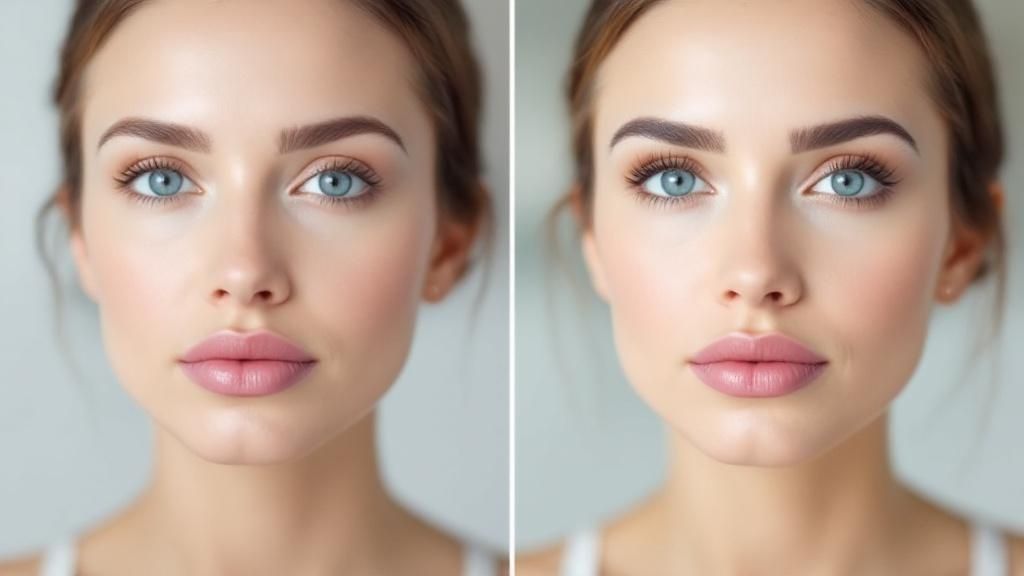
When deciding between Botox and dermal fillers like Restylane, it really boils down to a single, simple question: what are you trying to fix? The biggest difference between them is how they work, so the right choice always depends on the specific lines or volume loss you see in the mirror.
Here’s a simple way to think about it. If your lines are most obvious when you move your face—like frowning, smiling, or raising your eyebrows—you need a muscle relaxer. For those horizontal forehead lines that appear when you look surprised or the crow’s feet that fan out when you laugh, Botox is the direct solution. It works by gently relaxing the tiny muscles responsible for creating those creases.
But what if the line or hollow is still there when your face is completely still? That’s a sign you need a volumizer, and this is where fillers shine.
When Fillers Are the Answer
Dermal fillers like Restylane are engineered to restore lost structure and fullness. They are the perfect tool for aesthetic goals tied to volume loss or deep, static lines that have settled into the skin.
Consider these common scenarios where fillers are the go-to solution:
- Restoring Youthful Plumpness: If you feel like your cheeks have started to look a bit sunken or flat, a filler can rebuild that soft contour and provide a subtle, natural-looking lift.
- Correcting Under-Eye Hollows: That tired look from shadows under the eyes is often caused by volume loss. A carefully placed filler smoothes the area, erasing the hollows and making you look instantly refreshed.
- Softening Deep Folds: Static lines like the nasolabial folds (the "smile lines" from your nose to the corners of your mouth) need something to physically plump them up from underneath. A filler lifts the crease, creating a much smoother appearance.
A popular and highly effective strategy is the "liquid facelift," where a skilled provider like BARB N.P. combines Botox and fillers. This approach addresses multiple concerns at once for a full, non-surgical rejuvenation.
The popularity of these treatments clearly shows their different roles. Statistically, Botox has long held the largest market share, which makes sense given its dominance in treating the dynamic wrinkles that bother so many people. This is also influenced by how long they last; Botox results typically last 3 to 6 months, while fillers can last anywhere from 6 months to over a year. You can learn more about how these injectables compare in the facial injectables industry report.
Ultimately, the best results come from a personalized treatment plan designed around your unique facial anatomy and what you hope to achieve.
How Long Do Results Last? A Look at Timelines
When you're investing in an aesthetic treatment, one of the biggest questions is, "How long will this last?" It's a critical factor that shapes your budget, your schedule, and your long-term maintenance plan. The timelines for Botox and dermal fillers are completely different, and understanding them is key to making the right choice.
Botox works its magic for a relatively short period. Its muscle-relaxing effects typically last around 3 to 4 months. This means if you love that smooth, line-free look, you’ll want to plan for follow-up appointments with your provider, like BARB N.P., about four times a year to maintain it. If you want to get into the nitty-gritty of what makes it fade faster or last longer, you can learn more about how long Botox lasts in our detailed guide.
How Long Fillers Like Restylane Last
Dermal fillers are a different story. The longevity of products like Restylane can vary quite a bit, depending on a few key things: the exact filler used, where it’s placed, and your own body’s metabolism. Some of us just break down that hyaluronic acid a little faster than others.
Here's a general idea of what to expect:
- Lips & Fine Lines: In areas with a lot of movement, like the lips, results often last 6 to 12 months.
- Cheeks & Temples: When used for structure and volume in places like the cheeks, fillers can last up to two years.
A major breakthrough came when certain fillers were FDA-approved to treat hollowing in the temples, giving patients up to 13 months of rejuvenation. This shows just how much these products are evolving to tackle specific, nuanced signs of aging.
This timeline breakdown gives you a realistic picture of the commitment and investment for each treatment. It's all about making sure you know what to expect on your aesthetic journey as these incredible products continue to innovate and extend their results.
Your Personalized Consultation with BARB N.P.
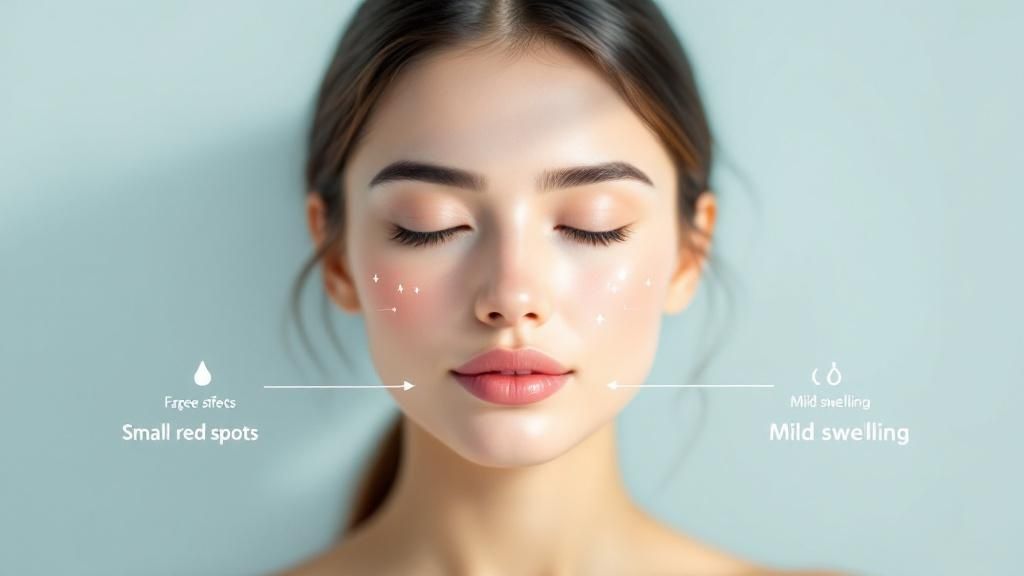
Knowing the difference between Botox and a dermal filler is a great start, but truly beautiful results come from a plan made just for you. Your facial anatomy, skin quality, and what you hope to achieve are completely unique. That’s why a "one-size-fits-all" approach just doesn't work in medical aesthetics.
This is where a professional consultation becomes so important. It’s not just about picking a product off a menu. It’s about partnering with an expert who can accurately assess your needs and design the right solution—or combination of solutions—to give you natural, confidence-boosting results.
Creating Your Custom Treatment Plan
During your consultation here at BARB N.P., we really take the time to listen. We’ll look at your facial structure and how your expressions move to figure out if Botox, a filler like Restylane, or even both would be the best fit for your goals.
A consultation is your opportunity to co-design your aesthetic journey. It ensures your treatment plan is perfectly aligned with your desired outcome, whether that's smoothing expression lines, restoring lost volume, or just achieving a subtly refreshed look.
Ultimately, my goal is to empower you with confidence. I provide a clear roadmap and make sure all your questions are answered, from what to expect during the procedure to long-term upkeep. For example, knowing how often to get Botox is a key part of planning your aesthetic calendar. You can learn more about Botox treatment frequency in our detailed guide.
Ready to take the next step? Let’s talk. Schedule your consultation at BARB N.P. today to get a personalized assessment and a treatment plan designed to help you look and feel like your absolute best self.
Your Questions, Answered
Once you understand the key differences between a neurotoxin like Botox and a filler like Restylane, the practical questions usually come next. Knowing what to expect during and after your treatment helps you feel confident and ready.
Can You Get Botox and Fillers at the Same Time?
Yes, absolutely. This is one of our most popular combination treatments for a reason! Pairing Botox with a dermal filler like Restylane in the same appointment is not only completely safe but also incredibly effective for a full-face refresh.
This strategy lets your provider tackle both dynamic wrinkles (from muscle movement) and volume loss in one go. At BARB N.P., we specialize in creating these comprehensive treatment plans, layering injectables for a result that looks balanced, refreshed, and totally natural.
Which Treatment Is More Painful?
Most people are pleasantly surprised by how comfortable both treatments are. While any injection can cause a brief pinching sensation, it’s generally very mild.
Many modern dermal fillers, including those in the Restylane family, come pre-mixed with lidocaine, a local anesthetic. This makes a huge difference in comfort during the filler injections. We can also apply a topical numbing cream beforehand for either treatment to ensure the experience is as pain-free as possible.
Our Take: Patients consistently tell us the sensation is just a quick, light pinch. The lidocaine in fillers is a game-changer, often making the procedure much more comfortable than they anticipated.
What Is the Expected Downtime?
Both Botox and fillers are famous for their minimal downtime, letting you get back to your life almost immediately.
- Botox: You might notice some tiny, pinpoint red marks or a touch of swelling right at the injection sites. This is normal and usually fades within a few hours.
- Fillers: These can cause a bit more swelling and have a higher chance of bruising. Don't worry—this is also normal and typically resolves within a few days to a week.
Most clients head right back to their daily routine straight from our office.
Ready to find the perfect solution for your aesthetic goals? At BARB N.P., we're dedicated to creating a personalized treatment plan that helps you look and feel your best. Schedule your consultation today.
